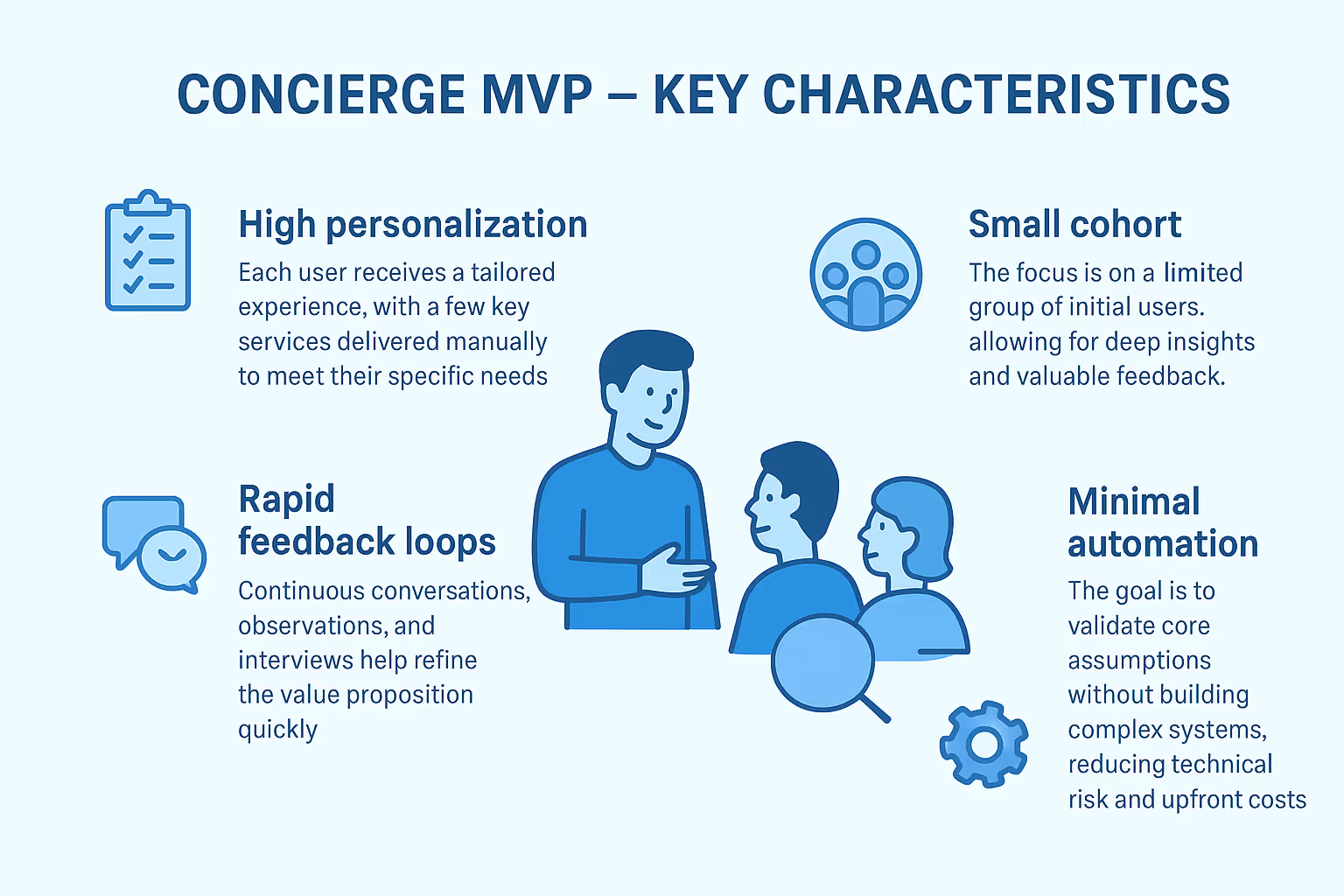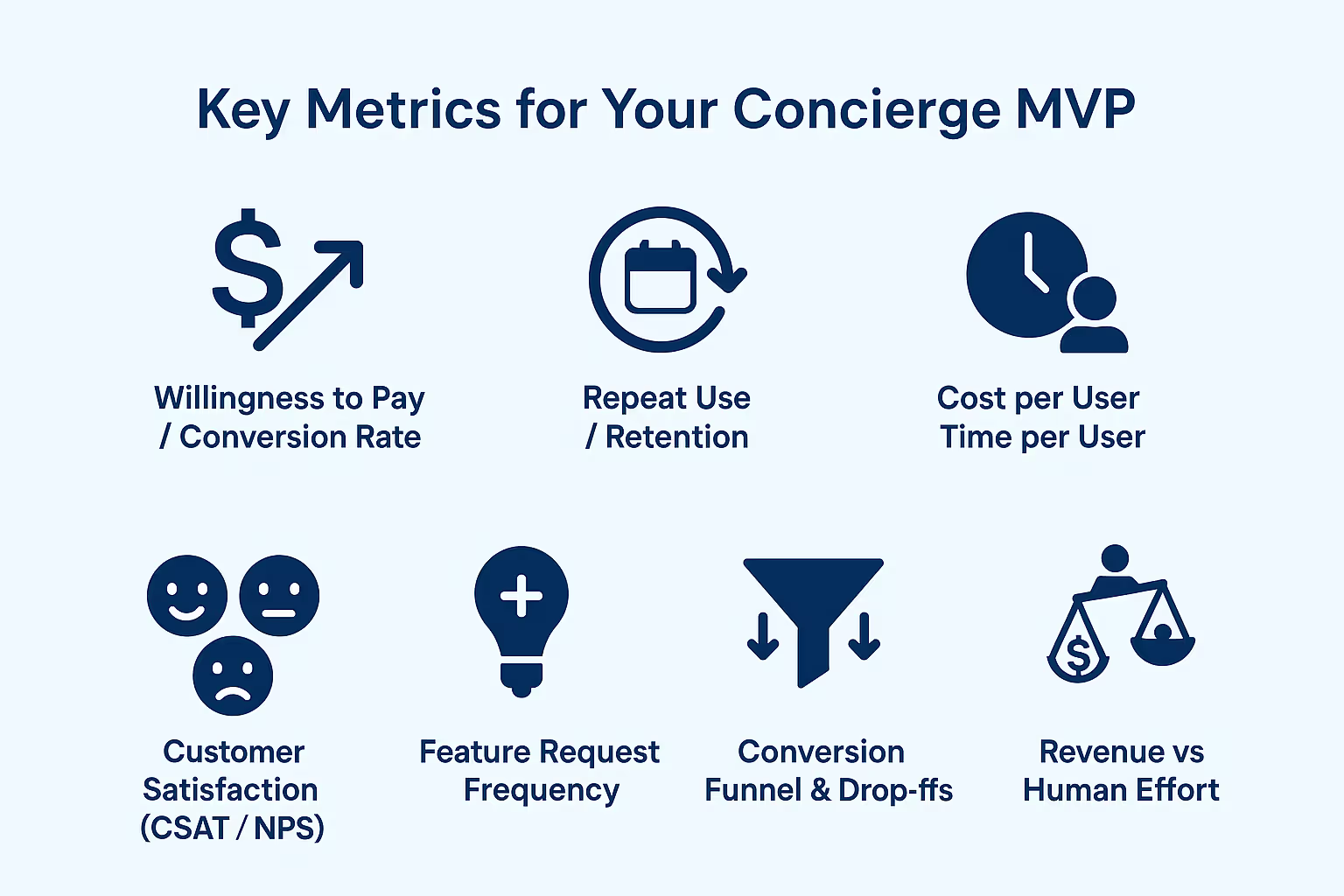
Learn when and how to implement the Concierge MVP effectively to enhance user feedback and drive product success. Read more to master your approach.

Recent data shows U.S. startup failures rose 60% in the past year — so testing business ideas before you build matters more than ever. A concierge MVP lets you understand and your idea is not just a flash validate assumptions by delivering a high-touch, manual version of your service to a small group of early users. Unlike traditional MVPs, it prioritizes personalized interaction, rapid feedback, and learning directly from prospective customers.
In this article, we’ll explain the concierge MVP definition, the key differences between it and other MVP types, how to run it, and how it can save you time and money.
A concierge minimum viable product (MVP) is a type of product test where you deliver your service manually, simulating what would eventually be automated. Instead of building a fully functional final product right away, you interact directly with a small group of early users, providing the service by hand while closely observing their behavior and collecting feedback. This approach helps validate your core assumptions through customer feedback at early stages, enabling rapid learning without heavy technical investment.
Unlike a standard MVP, which often relies on automated features or minimal core functionality, a concierge MVP emphasizes the personalized touch of hands-on delivery. Users are fully aware that the service is manual. This transparency sets it apart from the Wizard of Oz MVP, where the automation is hidden behind the scenes, making users think the product is fully built.
By running a concierge MVP, startups can deeply understand user needs, test complex or high-value ideas, and refine their value proposition before investing in full-scale development.
A concierge MVP stands out because it prioritizes direct interaction with users over automation, ensuring that the feedback is relevant before moving to the actual product.

Its key features include:
This approach ensures startups can test their ideas efficiently, uncover pain points, and adjust their offering by providing functionality manually before scaling or automating.
There are multiple idea validation approaches, and it’s important to understand how a concierge MVP differs from other approaches:
By choosing the right MVP type for your goals, you can save time, reduce costs, and perform a market pulse check to collect the valuable insights that matter most for achieving product-market fit for your startup. If you’re searching to hire developers for a startup, our experts will help you find the right talent to build, launch, and scale your MVP successfully.
A concierge MVP is a core concept when you need to learn deeply about your users before building a full product. It works best in situations where personalization, complexity, or niche markets matter more than speed or scale. Below are common use cases with real-world reasoning.
If your product idea or service needs to adapt to each user’s unique needs, a concierge MVP is ideal. For example, startups offering personal assistants, coaching, financial advice, or custom meal plans can test their service manually first. By interacting directly with users, you learn what they truly value, as you have personally helped clients in similar situations and can adjust your offering before investing in automation.
Some products require complicated technology or expensive systems to function. Instead of building everything up front, a concierge MVP test lets you deliver the service manually. This approach helps validate your core assumptions quickly and cost-effectively, while avoiding wasted time and resources on features users may not want.
When your audience is small but highly valuable, understanding every customer’s needs matters more than reaching many people. The MVP concierge allows you to spend time with each user, gain insights about user needs, and refine your service to fit the market precisely. This works well for specialized B2B services, luxury offerings, or other niche markets where having a super helpful concierge can make a big difference.
If your product is essentially a service, such as coaching, consulting, or advisory work, manual delivery is the fastest way to test demand. You can observe interactions, evaluate pricing, and adjust the process in real-time. This ensures that when you eventually automate, the product solves the right customer's problems for real users.
Using a concierge MVP in these scenarios helps startups reduce risk, save money, and design solutions that users actually want, although it often requires significant human effort. It’s about learning fast, concierge testing assumptions, and building a foundation for the final product hit of the bullseye. Our startup MVP development company helps you validate ideas faster, reduce risks, and turn concepts into market-ready products.
A concierge MVP offers many benefits, but it also comes with trade-offs. Understanding both sides helps you decide if it’s the right approach for your startup.
A concierge MVP is a powerful tool when used in the right context, but balancing its advantages with its limitations is key to running a successful experiment.

Say exactly what you want to prove.
Choose people who actually have the problem.
Map every step you will do by hand.
Be honest and clear from the start.
Do the work, watch closely, and write everything down.
Turn your data into a clear decision.
Real startups and teams have used MVP concierge to test big ideas without building full products. Below are easy-to-follow examples and the lessons they teach.
In The Lean Startup, Eric Ries tells the story of a company that tested a grocery/meal-planning idea by manually crafting personalized experience: they talked to shoppers, ran small experiments in stores, and delivered value by hand to learn what people actually wanted before startup software development. The lesson: when your idea touches complex, real-world behavior (like cooking or shopping), manual tests reveal what matters most.
Another concierge MVP example is Peerby. It tested a new rental model by creating a simple front-end where people could request items to borrow, while the team handled fulfillment and coordination manually. This lets them validate demand and the flow of requests without building a full rental system. It’s a great example of using a small, focused experiment to fast-track complex ideas.
Early Airbnb is often cited as a concierge-style test: the founders took photos of listings, communicated directly with hosts and guests, and managed bookings by hand. That hands-on work taught them about supply issues, pricing, and trust — inputs that shaped the product they later built. If you need to learn how real users behave when trust and logistics matter, such a single-feature MVP works.
If you want a team that can run hands-on experiments and then build the product, Empat’s case studies show how they move from discovery to the single-feature product development. Check examples like Monitree, Obimy, and PixShare to see how Empat handles product discovery, validation, and full development across fintech, health, and consumer apps. These case studies show the same pattern: learn with users first, then design and build with data.
Knowing when to stop doing things by hand and start building automation is one of the most important decisions in concierge services. Track simple, concrete metrics and watch for clear signals — not gut feelings. Below are the most useful metrics, suggested thresholds, and a practical plan for which parts to automate first.

Use thresholds as guides, not rules. Example signals that it’s time to automate parts of your concierge MVP:
If several of these signals line up, you have both demand and learning; it's the right moment to plan automation and hire remote developers.
Automate the parts that save the most time and deliver the most consistent customer benefit.
Start here:
Keep manual the high-value, relationship-building steps until you can match their value with the product (for example, expert reviews or personalized strategy sessions). Automate iteratively: outsource web development, build the smallest thing that reduces cost or increases conversion, measure the impact, then continue.
Many teams run a concierge MVP and learn useful things — but some common mistakes waste time or give misleading signals. Avoid these traps.
If you’d like, Empat can help you define the right metrics for your concierge MVP, run the manual experiment, and build the first automated pieces that matter most — from discovery and validation to full development. See Empat’s Discovery & Validation service and Software Development Outsourcing for more.
A few simple habits make a concierge MVP run smoothly and give you the cleanest, most useful learning. Keep these in mind from day one.
Start with a tight group of users on your target market who closely match your hypothesis (10–30 people). A small, well-chosen cohort gives clearer feedback, keeps the work manageable, and allows building deep relationships.
Be transparent: tell participants this is a manual test, what you will do for them, and what you won’t. Clear scope prevents disappointment, improves customer experience, and invites honest feedback.
Use short surveys after each interaction, schedule 30–45 minute follow-up interviews, and watch real sessions when possible (with consent). Combine quick quantitative signals (CSAT, conversion) with real user quotes — both matter.
Measure how long each task takes and what it costs. Log hours per step, multiply by hourly rates, and calculate cost per user. If you don’t measure it, you can’t decide when to automate.
Automate repeatable tasks that eat the most time or create the biggest bottlenecks (intake forms, scheduling, report generation, billing). Keep high-value human work until you can match it in the product.
If feedback consistently shows a different need than your hypothesis, change course fast. The whole point of a concierge service is to learn — use the data.
Create scripts, email templates, and checklists for repeatable steps. They make the manual work more consistent and help you measure where automation will have the biggest effect.
If demand grows, resist the urge to onboard everyone manually. Scale slowly and automate in small increments so you don’t break the experience you validated.
A concierge MVP is a fast, low-cost way to test a service by doing the work by hand for a small group of users with very little investment. It helps you learn what customers really want, prove willingness to pay, and avoid building features nobody needs. Use it when the value is personal, automation is expensive or risky, or you need deep insight before you build.
Checklist to decide if your idea needs a concierge MVP:
Simple roadmap from test to product:
If you want hands-on help running the test or turning results into a real product, Empat can run discovery, recruit early users, and build the automated MVP after validation. Ready to start? Contact Empat.
A concierge MVP is a way to test a service by manually performing for a small group of the target audience instead of building software first. You deliver a high-touch, tailored experience by hand, watch how people use it, collect real feedback, and learn whether the idea has value before you invest in automation.
A simple real-world example: founders personally took photos, answered messages, and handled bookings for early Airbnb listings to learn how hosts and guests behaved. A small startup might offer personalized meal plans by talking to each customer, creating plans by hand, and sending them in PDF — then use what they learn to decide what to build.
The main difference is transparency. In a concierge MVP, users know the service is manual and expect hands-on help. In a Wizard of Oz MVP the team hides the manual work, and users think the product is automated. Concierge focuses on open, high-touch learning; Wizard of Oz tests perceived automation and flow without revealing the manual backend.


